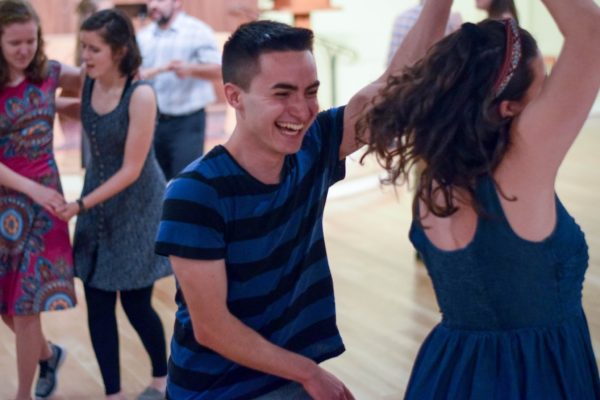 Photo by Caroline Clymer
Photo by Caroline Clymer
Dress for lessons:
Don’t feel any need to dress up for lessons! What you wore to class is probably fine, unless it’s particularly restrictive, will make you uncomfortable if you spin or jump or sit on the floor in it, or you really don’t want to get it sweaty. (We won’t sweat most days, but sometimes we do, so don’t wear a tux!)
It’s generally considered nice for dancing to be able to slide across the floor. Many of us just wear socks for lessons. Rubber-soled shoes can make it difficult to do things like swivels and fast turns. Suede soles are probably the best, but they are by no means necessary! (If you’re committed and bougie, consider dancestore.com. If you’re committed but spent $8675 on textbooks, consider picking up Shoe Goo, cheap shoes, and a sheet of suede.)
When we teach lifts, we recommend that both leads and follows wear comfortable clothing.
Dress for social dances:
Wear what you want! Each dance has a theme, and you can choose to dress for that theme or not. Example themes include Halloween, James Bond, and the Roaring 20’s. At every dance you’ll find flannels, gowns, and everything in between. Clothing isn’t gender or role restricted, but please do verify that you can dance in your chosen outfit before coming! (Or just bring a change of shoes.)
Initiate a dance:
ALWAYS ask someone to dance; don’t just grab their hand! Anyone can say no to a dance at any time for any reason. This includes in the middle of a dance! Consent is INCREDIBLY important, and we reserve the right to ask you to leave the dance if this is a problem. Also, if you want to perform a lift/aerial/air step or a dip, ALWAYS ask your partner if they’re comfortable with it. We ask that aerials and lifts are only performed during jam circles for everyone’s safety. Rules for our jam circles are posted outside and inside our dance venues!
Choose a role:
Swing dance is a partner dance, and each partnership consists of one lead and one follow. Leads are the ones who set the shape of the dance and decide each move, and follows are the ones who listen to their lead’s nonverbal instructions, perform the moves with them, and add flair. When swing dance was originated in the 1920’s, men led and women followed, but we have no preference and ask that you respect other’s choices on what position they prefer.
You can switch roles from lesson to lesson, but to make it easier on your brain, we recommend sticking to one role in a single lesson. We also suggest that beginners stick to one role while they’re learning and then go back the next semester and take the beginner lesson series as the opposite role.
Become a better dancer:
First and foremost: Dance! Go to lessons, social dances, dance with your friends in your dorm room, practice spins and solo jazz in your kitchen. Lots of dance opportunities will be posted on the calendar on this website and the JMU Swing Dance Facebook group and GroupMe, and we’re always happy to give rides to whatever dances we’re going to. No, seriously, it’s not a hassle- we’d be delighted to have more company, even if it’s last-minute.
Watch dance videos! We’ll be posting videos on Facebook weekly, but there are lots more than the small sampling that will provide. Procrastinating feels way more productive if you’re watching dance videos instead of Netflix. If you see a cool move in a video, try it out next time you dance!
Learn about the history of the dance! From Whitey’s Lindy Hoppers to the 80’s Swing Revival to ILHC 2019, swing dance has a really rich and continuing history, and learning more abut this facet of the dance can help you understand the dance in general.